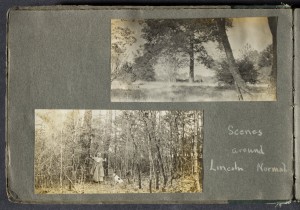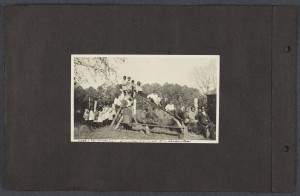By: Christa Vogelius, CLIR Postdoctoral Fellow
In August 2014, the Tuscaloosa Magnet Middle and Elementary School will be showcasing “Scenes Around Lincoln Normal,” a traveling exhibition of reproduced materials that illustrates the history and contexts of two early twentieth-century photograph albums from the A.S.Williams III Americana Collection at The University of Alabama. The albums, which are digitized and available to view online through Acumen, record scenes from the daily lives of teachers, students, and administrators at the Lincoln Normal School in Marion, Alabama, an elementary and high school that opened immediately following the Civil War for the education of freedmen, and was operational as a landmark African-American institution until 1970.
“Scenes Around Lincoln Normal” is the inaugural show of the Division of Special Collections’ traveling exhibition program, which will create physical displays of digitized materials that will circulate in local schools, libraries, and institutions, showcasing UA’s holdings—many of which document the history and the culture of the state— to a broader public.
The Lincoln Normal School: History and Context
The Lincoln Normal School in Marion, AL was among the first schools established for the education of freedmen after the Civil War. Popular legend locates the school’s inspiration in a former Union soldier who began to teach local African-American children to read immediately following the war. The school was incorporated in 1867 by a group of nine local African-American men, all former slaves, who acquired both a plot of land in the western part of Marion, and the first school building. By 1868, the founders had secured the financial and administrative support of the American Missionary Association, an auxiliary of the Congregational Church that help to establish and maintain over five hundred schools in the South during the Reconstruction era.
In the over one hundred years of its existence, the Lincoln Normal School operated under several different forms. In its early years, it was a privately-operated school. Beginning in 1873, it was also associated with the publicly-run State Normal School (or Lincoln Normal University), which trained African-American teachers. After a fire destroyed the State Normal School in 1887, this section of the institution moved to Montgomery. It would later become Alabama State University, the first public Historically Black College (HBC) in the nation. The primary and secondary schools in Marion remained operational until 1970, and were publicly funded after 1943.
Lincoln Normal struggled financially throughout its existence, but left an important intellectual legacy in the African-American community. In addition to laying the foundation for Alabama State, a university that currently trains more teachers than any other institution in the state, Lincoln Normal provided a progressive and innovative model of education for its younger students. This foundation encouraged the later pursuit of higher education: sociological research from the 1970s showed that of a group of 500 African-American PhD recipients, a disproportionate number had roots in Perry county, where the Lincoln Normal School had been a part of their family histories. Notable alumni include Coretta Scott King and her sister Edythe Scott Bagley; former federal judge William Hastie; and sociologist Andrew Billingsley.
The Lincoln Normal School Albums at The University of Alabama
The A.S. Williams III Americana Collection at the University of Alabama owns two captioned Lincoln Normal School photograph albums with images from 1909- 1924, bought as a set by the collector A.S. Williams from a Birmingham book dealer. Both offer a rare glimpse into the lives of Lincoln Normal students and teachers at an important moment in their school’s history and were likely kept by teachers at the school. In 2010, The University of Alabama acquired the albums as part of the Williams Collection, and they are stored with the rest of the archive on the third floor of Gorgas Library.
The exhibition at the Tuscaloosa Magnet School during the spring semester will highlight the place of these photograph albums in both African-American and women’s history. The albums document scenes including posed group portraits of teachers and administrators, and informal shots from daily, celebrations, and performances. The time span of the albums, from 1909 to 1924, was a pivotal moment in the landmark institution’s history; these were years that the school expanded dramatically and many of its campus buildings were constructed under the leadership of the influential principal Mary Elizabeth Phillips. Both albums include rare pictures of the teachers’ quarters and “Miss Phillips,” captioned images of students and teachers, and short transcriptions of songs from student performances.



